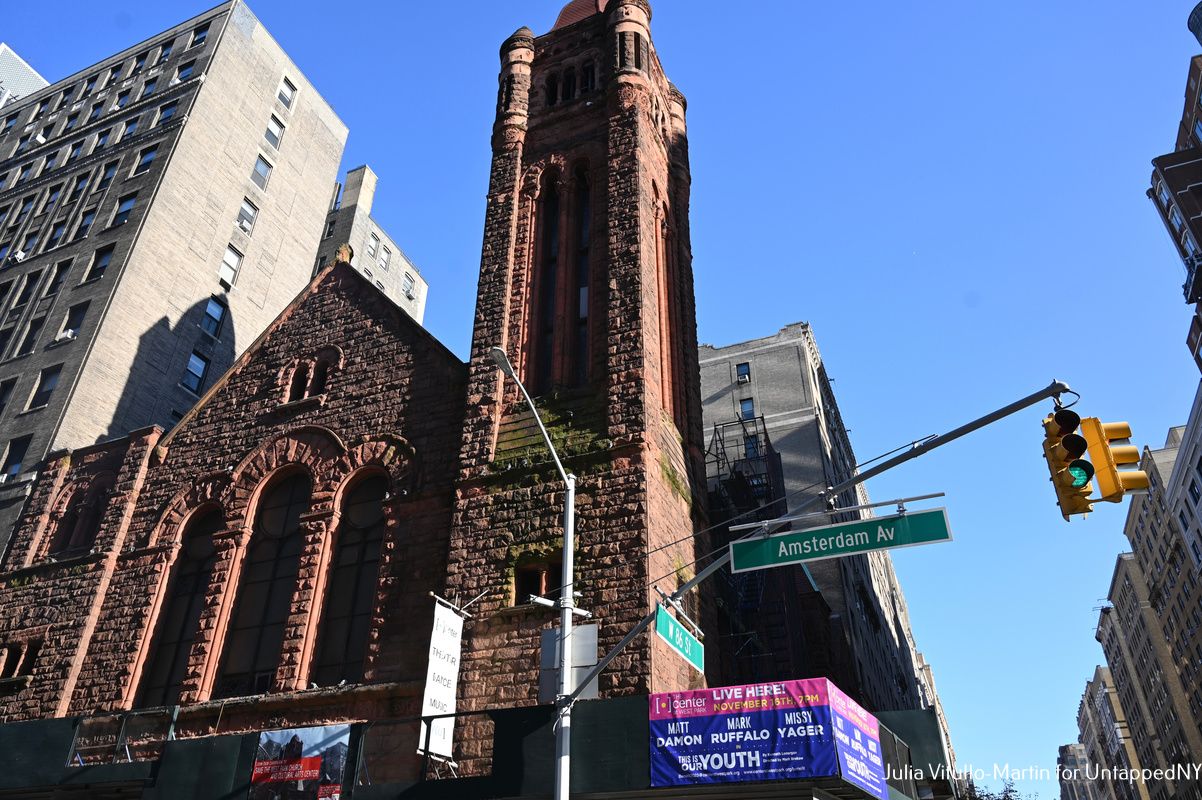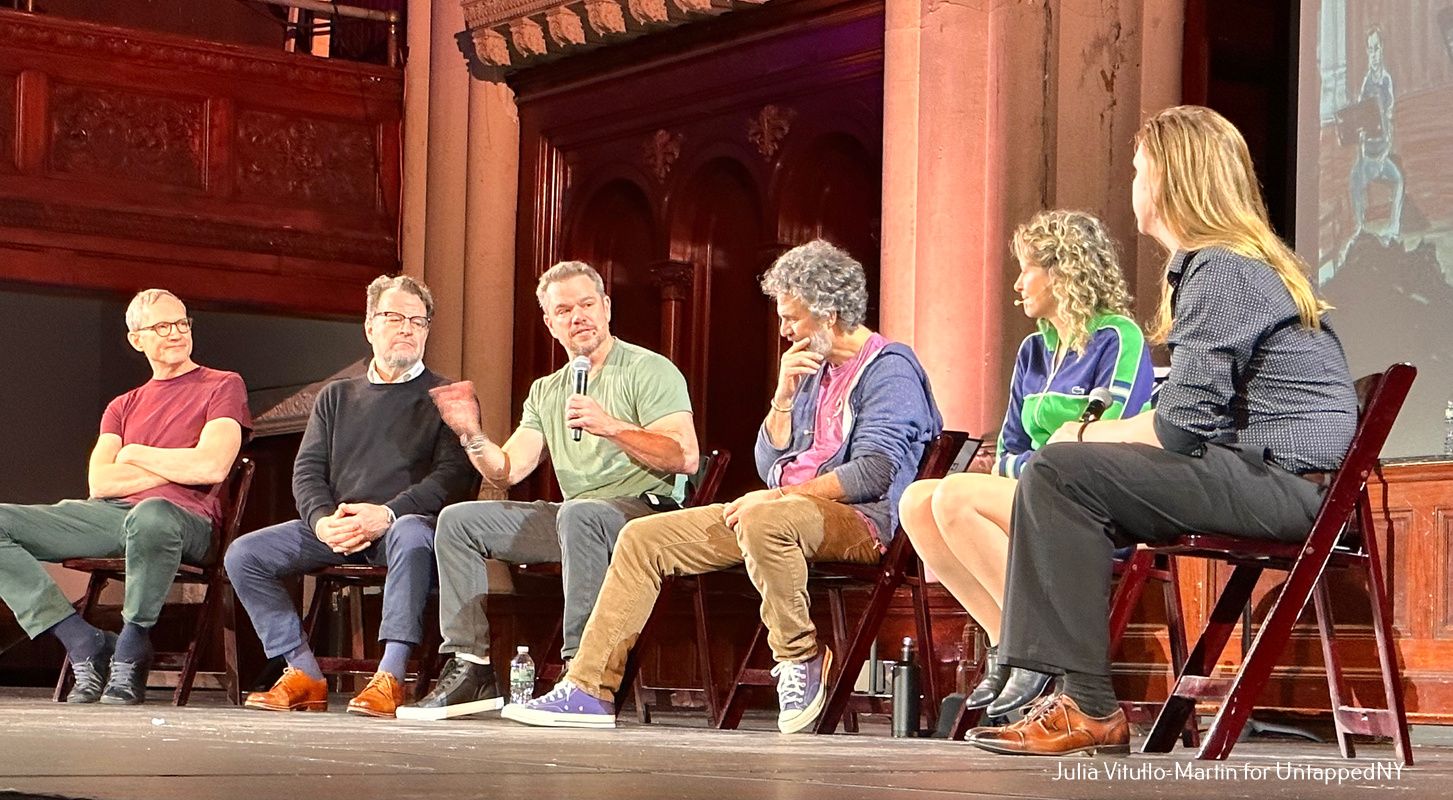Last-Minute NYC Holiday Gift Guide 🎁
We’ve created a holiday gift guide with presents for the intrepid New Yorker that should arrive just in time—


One of Manhattan’s most beautiful landmarked churches—the West Park Presbyterian Church on the Upper West Side—has been surrounded by ugly scaffolding for over 20 years, its windows have been dark and foreboding, its entrances unwelcoming, and its lovely red sandstone crumbling.

Despite community efforts to save the church and offers to buy it, its owner, the Presbytery of New York City, has refused all overtures. Instead, it set up the West Park Administrative Commission last spring to facilitate the sale of the building to a high-paying developer. Then it entered into a Purchase and Sale Agreement with Alchemy Properties, which announced that it intends to demolish the landmarked church and replace it with a 19-story residential tower.
Not so fast, said preservationists, artists, community members, and Gale Brewer, who represents the UWS in the City Council. The church was landmarked in 2010. Before the Presbytery can order its demolition it must prove economic hardship, a barrier deliberately set high by the Landmarks Commission and New York City’s administrative code.
Throwing down the gauntlet, Brewer testified before Landmarks: “The applicant is seeking to demolish this last-of-its-kind church, not by reason of economic hardship, but rather as an economic opportunity.” The Presbytery is crying poverty, but Brewer suggests that it is simply seeking profits, an altogether different matter.
To demolish the church the Presbytery must meet four statutory requirements. First, it must enter into a legitimate sales agreement contingent on getting demolition approval from Landmarks. The Presbytery has indeed signed a sales agreement. It is hoping—and lobbying—for the second half of the requirement, demolition approval.
Second, the Presbytery must show that the church cannot earn a reasonable return. This has always been an uncomfortable criterion for non-profit organizations, especially churches, which aren’t ostensibly in the profit-making business. But return is at the core of the Presbytery’s argument—that it is entitled to make a minimum of 6 percent on its property. This, it argues, it cannot do with the existing, deteriorating building.
Third, improvements alone will not succeed in making the church fulfill its intended charitable purpose of worship combined with ministerial activities.
Fourth, the prospective purchaser—Alchemy—must have a good-faith plan to construct a new project immediately after the demolition. Alchemy indeed has a “good-faith” plan, but it cannot begin construction immediately.
The Presbytery’s application for hardship was premature, says Sean Khorsandi, executive director of Landmark West! An application for hardship must include a project that is ready to go, which the Alchemy project is not. For one thing, there is an existing tenant—the Center for West Park—with five years to go on its lease.
Brewer notes that “because the church is owned by a religious corporation, any sale of the property must be approved by the court. The Center’s attorneys have searched the docket and have not found any filing by the applicant to obtain judicial approval of the sale.”
What’s more, pushes Khorsandi, what is the church’s charitable purpose that it cannot now meet? The sanctuary is used every Sunday for worship, multiple organizations rent space for community purposes, and the arts groups put on well-attended performances. What’s your checklist for charitable purposes? What charitable function can’t you do now in the existing church?

He believes that with at least these two hardship criteria unmet, the Landmarks Commission will not be able to allow demolition to proceed. This gives breathing room to the tenant, the Center for West Park, to get its house in order as a truly viable caretaker of the building.
After years of contention—arduous community efforts followed by hopelessness—the landmarked church building at last has a realistic chance at being saved. In May the arts group that is leasing the church–the Center at West Park—hired a new executive director, Debby Hirshman, who is an effective advocate for preserving the building. “Not only would it set an unjust precedent that these historic buildings could be demolished, but it would also erase a piece of history in our own backyard,” she told The Real Deal.
Neighborhood residents have long complained that the church is a bad neighbor, looking relentlessly grim and doing nothing to welcome people in. “To be gentle,” says architect Page Cowley, “the Presbytery has always had a turned-up nose about preservation. They didn’t care what the church looked like on the outside, just what happens on the inside. They haven’t done anything to promote its beauty. When I walk by I think I should bring Windex and paper towels, and maybe get a tetanus shot first. I’d like to see the Center’s new leadership light the entrances properly, both to show off the handsome building and to welcome people in. Is the building safe to enter? Yes, but light it properly so that people are attracted.”
In the few months since her hiring, Hirshman has launched a series of successful events, welcoming new audiences and bringing in substantial money.
The most spectacular was a two-night benefit reading of Kenneth Lonergan’s hit play, This Is Our Youth, starring Mark Ruffalo and Matt Damon. “How do you get a star like Matt Damon to appear in a benefit performance of a play in a church on the Upper West Side?” wrote James Barron of The New York Times. “You ask him,” responded Lonergan. Damon had lived for a few years in the Belnord, across the street from the church, and wanted to “keep what’s special about the neighborhood special,” said Lonergan.

Lonergan had grown up in the west 90s near Central Park and attended what the Times characterized as “the somewhat famously liberal Walden School, whose alumni include Barbara Tuchman and Matthew Broderick, whom Lonergan calls ‘my very best friend in the world.’”
Youth—or TIOY, as Ruffalo says—is set on the UWS in the early 1980s. Called a “devastating portrait of Upper West Side rich kids and their amoral, self-abusive, patternless lives,” it’s all about a certain kind of wealthy, progressive privilege that was almost familiar to many audience members. Warren, Ruffalo’s character, says of his upbringing in the liberal 1960s, “It’s like my Dad’s always saying, ‘Do you know how bad you guys would have to fuck up before anything really serious ever happened to you? (Pause.) You and all your friends from the Upper West Side who went to that fuckin’ school where they think it’s gonna cripple you for life if they teach you how to spell? (Pause.) Do you know what happens to other kids who do the kind of shit you guys do? They die, man. They go to prison or they shoot each other, and the only difference between you and them is my money.'”
You could have heard a pin drop in the church as Ruffalo read his lines. For while this was a reading, the actors spoke with all the depth and nuance of a polished West End play, where indeed Matt Damon made his London debut in this very play at the Garrick Theatre.
After the performance, Ruffalo and Damon were joined by Lonergan, Hirshman, Missy Yager, TIOY director Mark Brokaw, and program director Nick Browne for a 15-minute talkback with the audience. The entire audience stayed.

Since 1965 the Landmarks Commission has dealt with 19 hardship applications and approved 13 of them. Will West Park be next? Khoursandi hopes not. He says of the Presbytery, “What we have are negligent stewards who shouldn’t be rewarded for bad behavior, for letting their building deteriorate. We don’t want this to be a road map so that every other religious nonprofit sees a future in demolition.”
The UWS alone has some 70 religious structures, nearly all on prime property, and many facing serious financial trouble. What is ahead? Revitalization? Or destruction?
In what is surely the biggest planning surprise of 2024 so far, the Upper West Side’s West Park Presbyterian Church has abruptly withdrawn its application to the Landmarks Preservation Commission seeking a hardship declaration in order to demolish its individually landmarked building. This was especially astonishing because the church had only recently pressed Landmarks to schedule a hearing leading to a final commission vote on Tuesday, January 9. That day already had a crowded agenda, but Landmarks nonetheless complied.
Now there is no hearing, no vote, and not even an application. What is going on?
In a letter to the commission, the church’s lawyers said that it was withdrawing its application until it resolves its lawsuit against a tenant over a lease dispute. Yes, as Landmark West’s executive director Sean Khorsandi says, “Not to toot our horn but we’ve been saying all along that the applicant did not meet Landmarks’ necessary criteria. My understanding is that they realized they were not shovel-ready, as Landmarks requires, because the existing lease stood as a clear impediment to immediate demolition. In order to grant hardship, all criteria must be met and the threshold is high.” The lessee, the Center for West Park, has the four years stipulated in its lease to raise the necessary money to restore the building.
Adds Khorsandi, “Landmarks has four criteria to be met, and shovel ready—move to demolish immediately—was one of them. We mentioned it at each point in our testimony but nobody seemed to notice.”
The West Park congregation issued a subdued statement:
“Our congregation remains wholly committed to a future for the West Park Presbyterian Church that will be made possible by the sale of property and a permit from the Landmark Preservation Commission (LPC) to demolish the existing building on the grounds of hardship. Today, however, we are withdrawing our application before the LPC as we await resolution in the unrelated litigation concerning the expired lease of the building’s tenant.
We have faith that the court will decide in the congregation’s favor as it evaluates the lease litigation, and we plan to resubmit our application to the LPC when the litigation is resolved so that we can finally invest in the modern, accessible worship and community space that the Upper West Side deserves and further support our mission in our neighborhood and across New York City. We are confident that the hardship analysis presented in the application is accurate, as affirmed by independent reviews, meets the requirements of the Landmarks Law, and will ultimately be approved by the Commission.
We want to thank those who have spoken up in support of our congregation’s efforts to restore our church and renew our mission in service to our community. Our decision in 2022 to pursue the sale of our spiritual home for over 150 years, where our members made history as advocates for social justice and global peace, was not made lightly. After more than two decades of trying to keep up with repairs and waiting for unfulfilled promises of fundraising to come through, we ran out of time and money and must explore other options for our congregation’s future.”
As Landmark West summarized on its blog the withdrawal means that the landmarked church is no longer facing immediate demolition for replacement by luxury residences. It means the Center for West Park can remain on site for at least the remainder of its lease and they can see through to their commitment to remove the scaffolding.”West Side Councilmember Gale Brewer doubtless spoke for many of her constituents in saying, “I am ecstatic that the Presbyterian Church has withdrawn their application for a hardship application. Now the WPPC can continue as a landmark and we will work with the nonprofit to purchase the Church and to renovate it.”
Both sides now have four years to prove their case.
Next, check out 15 NYC Landmarks that Aren’t Buildings
Subscribe to our newsletter